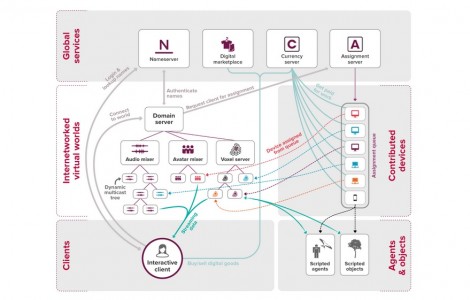High Fidelity founder and CEO Philip Rosedale released a blog post a couple of days ago outlining the company’s network architecture.

One unique aspect of the platform is that virtual objects are stored in the form of voxels, which can be nested inside one another or averaged together.
This allows a large number of objects to be viewed at a distance, since the voxels average together, with, say, an entire tree becoming just a speck on the horizon.
In addition, a city can be composed of buildings full of fully-furnished apartments, with each apartment stored on a separate server.
“In this way, cities and other interesting virtual space can be created containing an almost infinite amount of content,” he wrote.
Peer-to-peer
Another interesting aspect of the plan is for voice communications and avatar movements. Typically, voices and movements are transmitted from the user to a central server, and the server then transmits the information to all the other users, a “hub and spoke” model.
With High Fidelity, the central servers can be augmented by distributed, peer-to-peer communications, similar to the way that Skype works, or BitTorrent.
Another innovative peer-to-peer functionality is that of paying users for processing that’s done on their computers through the use of cryptocurrency.
That cryptocurrency will also be used to allow people to buy and sell virtual goods, either directly or through High Fidelity’s virtual marketplace.
Rosedale did not specify what exactly the cryptocurrency will be.
The most popular cryptocurrency in use today is BitCoin, but High Fidelity can also simply create its own.
“
- International singers gather on Alternate Metaverse Grid for first annual International Day - April 15, 2024
- OpenSim hits new land, user highs - April 15, 2024
- Wolf Territories rolls out speech-to-text to help the hearing impaired - April 15, 2024
